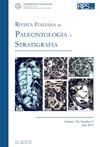来自黑海西部陆架的雷蒂亚有孔虫:古特提斯时期异虫碳酸盐工厂的新证据
IF 1.9
3区 地球科学
Q2 GEOLOGY
引用次数: 0
摘要
北多布罗吉造山带(NDO)是阿尔卑斯-喀尔巴阡造山带东部前陆的一个NW-SE走向的褶皱和冲断带,在古地理上代表了古特提斯发布的Cimmeride造山系的最西段。向东,NDO在结构上延伸到黑海西部大陆架的罗马尼亚部分。北多布罗盖亚的三叠纪发育以其特提斯型相和丰富的化石群而闻名,但对近海三叠纪的微相和化石含量却很少关注。罗马尼亚近海Lebada Vest油田的817 LV钻孔终止于Rhaetian(上三叠纪)石灰岩奥氏岩,从中发现了丰富的有孔虫和介形虫组合。石灰岩中还含有海绵针状物、软体动物碎片、棘皮动物化石、苔藓动物和腕足动物。残留物中的有孔虫组合仅由凝集物种组成。Tolypamminids、Gaudryinopsis triadica(Kristan Tollmann)、G.triassica(Trifonova)、G.kelleri(Tappan)、Ammobaculites tzankovi(Trifonova)、A.zlambachensis Kristan Tollmann、Verneuilinoides racema(Trifonova)和Trochammina spp.占主导地位。从薄片中确定的非凝集物种包括Ophthalmicium spp.,以及罕见的总苞属Trocholina ex gr.intermedia/umbo和“总苞属”(总苞属ex gr.liassica)。丰富的介形虫群落以白介形虫科为主。Paracypiridae和Sigillidae科的物种相当常见。此外还发现了Norigondolella steinbergensis牙形石(Mosher)。沉积被认为发生在一个相对较深的环境(外陆架)中,在相对较冷的水域中,以海洋杂生物为主的平台上。本文章由计算机程序翻译,如有差异,请以英文原文为准。
RHAETIAN FORAMINIFERS FROM THE WESTERN BLACK SEA SHELF: NEW EVIDENCE FOR HETEROZOAN CARBONATE FACTORIES IN THE PALAEOTETHYS
The North Dobrogean Orogen (NDO) is a NW-SE trending fold-and-thrust belt in the eastern foreland of the Alpine Carpathian Orogen, palaeogeographically representing the westernmost segment of the Palaeotethys-issued Cimmeride Orogenic System. Eastwards, the NDO structurally extends into the Romanian sector of the western Black Sea continental shelf. The Triassic development of North Dobrogea is well known for its Tethyan-type facies and richness in various groups of fossils, but little attention has been paid to microfacies and fossil content of the offshore Triassic. The drill hole 817 LV of the Lebada Vest oilfield, offshore Romania, ends in the Rhaetian (Upper Triassic) limestone olistolith, from which a rich association of foraminifers and ostracods was recovered. The limestone also contains sponge spicules, mollusc fragments, echinoderm ossicles, bryozoans, and brachiopods. Foraminiferal assemblage from the residue consists of agglutinated species only. Tolypamminids, Gaudryinopsis triadica (Kristan-Tollmann), G. triassica (Trifonova), G. kelleri (Tappan), Ammobaculites tzankovi (Trifonova), A. zlambachensis Kristan-Tollmann, Verneuilinoides racema (Trifonova), and Trochammina spp. predominate. Non-agglutinated species, determined from thin sections include Ophthalmidium spp., and rare involutinids Trocholina ex gr. intermedia/umbo and “Involutina turgida” (Involutina ex gr. liassica). The rich ostracod assemblage is dominated by Bairdiidae. Species of the Paracyprididae and Sigilliidae families are rather common. The conodont Norigondolella steinbergensis (Mosher) was also found. The deposition is suggested to take place in a relatively deep setting (outer shelf) offshore heterozoan-dominated platform in relatively cool waters.
求助全文
通过发布文献求助,成功后即可免费获取论文全文。
去求助
来源期刊
CiteScore
3.60
自引率
4.30%
发文量
28
审稿时长
>12 weeks
期刊介绍:
The Rivista Italiana di Paleontologia e Stratigrafia was founded in 1895. It publishes original papers dealing with all fields of paleontology and of stratigraphy, from Italy and the Mediterranean to the Tethys, as well across the globe from China to North America.

 求助内容:
求助内容: 应助结果提醒方式:
应助结果提醒方式:


